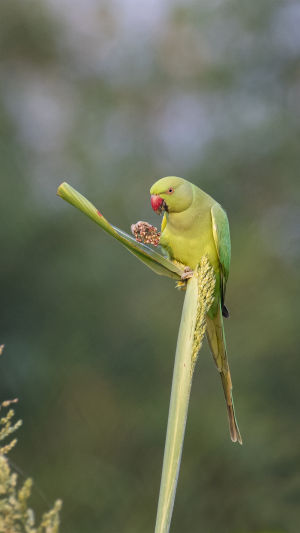Parrots have a strong ability to speak, are gifted, have a high IQ, and are renowned for their ability to imitate human speech.
Parrots usually act together in small groups when foraging, preferring to eat all kinds of seeds, nuts, fruits, berries, etc. Sometimes they also eat flowers and bark, as well as insects and snails, and even go to crop fields to forage, causing agricultural losses, especially in cornfields.
Parrots can search for fruit trees over long distances and will migrate seasonally, especially in the dry season. Gathering in large flocks while roosting can be very noisy.
Parrots make quacking, whistling, and screeching sounds both at rest and in flight. In addition to being able to imitate human speech, parrots have also been found to mimic the sounds of other birds and mammals in the wild.
In some tasks, parrots have been shown to have the cognitive level of a 4 to 6-year-old child, and the parrot's superb mimicry alone indicates that the parrot's intelligence can be considered very high in the animal kingdom.
The African Grey parrot is one of the most intelligent of parrots, with an IQ equivalent to that of a 4-6-year-old human child. In addition, the African Grey Parrot is one of the few animals known to be able to talk to humans and has an excellent ability to speak.
New experiments have shown that African grey parrots can learn number sequences and can associate human voices with human faces.
Most notably, Dr Erin Pepperberg worked with an African Grey parrot named Alex to show that it can learn over 100 words and also distinguish between objects, colours, materials, and shapes.
The African Grey Parrot is very intelligent and can use words and numbers appropriately and can converse smoothly with humans.
If you can train them properly, some African Grey parrots can also distinguish colours and create their vocabulary, which is simply incredible, and they will pass on what they have learned to the next generation.
Parrots are strong learners and they can learn by seeming to learn, for example, a parrot in an Oxford University laboratory used Archimedes' principle to make a long metal wire into a curved hook to catch a fish out of a test tube.
In this period, scientists have come to believe that birds are very intelligent and their brains are similar to those of humans. A huge discovery about parrots was published in Current Biology, a sub-journal of the top international academic journal of biology, Cell.
A Goffin's cockatoo named Figaro surprised some scientists from the UK and Switzerland by making and using tools to get what it wants.
Through the scientists' experimental observations, they discovered that the cockatoo can use tools to get something and also make simple tools, which shows that the intelligence of the cockatoo is not only reflected in the ability to imitate, but it can also think independently.
Through various experimental proofs, we can determine that parrots are very intelligent birds. Of course, the intelligence of the parrot is not only related to its genetic and natural spirituality but also inextricably linked to the training of the bird trainer later on.
For example, when a parrot is with an outstanding bird trainer, its IQ will also become higher. Therefore, when we want to cage a very intelligent parrot is also closely related to the development of their own teachings.





